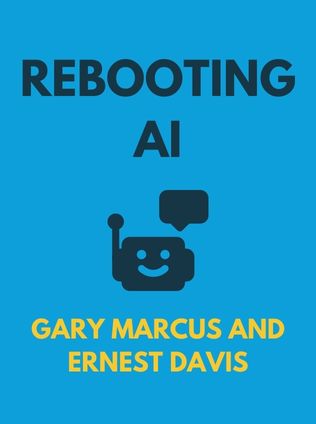
Rebooting AI
Building Artificial Intelligence We Can Trust
By Gary Marcus and Ernest Davis
Published 09/2019
About the Authors
Gary Marcus and Ernest Davis are two renowned figures in the field of artificial intelligence (AI), each bringing a unique perspective to the table. Gary Marcus, a cognitive scientist with a Ph.D. in psychology, is well-known for his critical stance on the current trajectory of AI research. He is the founder of the companies Geometric Intelligence and Robust.AI, both of which focus on making AI more robust and reliable. Marcus is also an accomplished author, having penned several books on learning and cognition, including Kluge and Guitar Zero. His deep understanding of human cognition and his skepticism of overhyped AI promises make him a formidable voice in the debate over AI’s future.
Ernest Davis, a professor of computer science at New York University, complements Marcus’s expertise with his deep knowledge of AI, particularly in the area of commonsense reasoning. Davis has written extensively on AI, including the influential work Representations of Commonsense Knowledge. His research focuses on the limitations of current AI systems and the complexities of embedding human-like reasoning into machines. Together, Marcus and Davis provide a well-rounded critique of AI, combining psychological insights with technical expertise.
Main Idea
In their book Rebooting AI, Gary Marcus and Ernest Davis argue that while AI has made impressive strides, it is still far from achieving true intelligence. They contend that the current focus on narrow AI, driven by big data and machine learning, is insufficient to create systems that can truly understand and navigate the world as humans do. The authors caution against the overhyping of AI’s capabilities and warn that without a significant shift in research focus, we risk building unreliable systems that could have dangerous consequences. They advocate for a more holistic approach to AI development, one that draws on insights from cognitive science, neuroscience, and psychology to create machines that can genuinely think and learn like humans.
Table of Contents
- Introduction: The Hype and Reality of AI
- The Limits of Narrow AI
- Understanding How AI Works
- The Problem of AI Hallucinations
- The Challenge of Language Comprehension
- AI and Real-World Awareness
- Towards Strong AI: A New Direction
- Human-Level Cognition: The Ultimate Goal
- The Road Ahead: Higher Standards for AI
Introduction: The Hype and Reality of AI
The public perception of AI is often shaped by a mix of science fiction and sensational media reports, leading to a widespread belief that AI is on the brink of achieving human-like intelligence. However, as Marcus and Davis point out, the reality is far different. The AI systems that currently exist are examples of what the authors call “narrow AI”—programs designed to perform specific tasks, like recognizing faces or translating languages. These systems are far from the “strong AI” that can think, reason, and understand the world like a human being.
The authors argue that this disconnect between perception and reality is dangerous. When people believe that AI is more capable than it actually is, they are more likely to trust these systems in situations where failure could have serious consequences. This misplaced trust is compounded by the fact that AI developers and tech companies often oversell the capabilities of their products, leading to inflated expectations.
The Limits of Narrow AI
Narrow AI systems, while impressive in their specific domains, have severe limitations. Marcus and Davis emphasize that these systems do not possess true understanding; they are essentially “hyper-focused morons” that can excel at one task but fail miserably when faced with anything outside their narrow expertise. For example, a facial recognition system may be highly accurate in identifying faces in a controlled environment, but it can easily be fooled by changes in lighting or angle.
Sign up for FREE and get access to 1,400+ books summaries.
You May Also Like
The Subtle Art of Not Giving a F*ck
A Counterintuitive Approach to Living a Good Life
By Mark MansonHow To Win Friends and Influence People
The All-Time Classic Manual Of People Skills
By Dale CarnegieFreakonomics
A Rogue Economist Explores the Hidden Side of Everything
By Steven D. Levitt and Stephen J. DubnerQuiet: The Power of Introverts
The Power of Introverts in a World That Can't Stop Talking
By Susan Cain



















